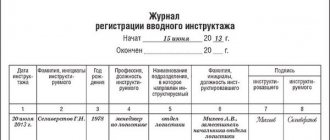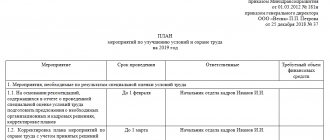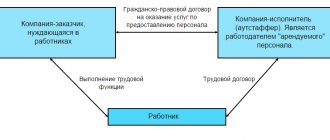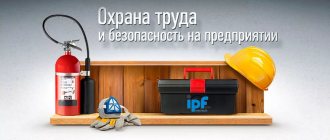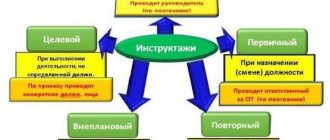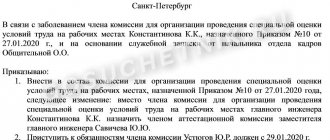Occupational safety and health at the enterprise: main points
Labor safety rules were not just invented by legislators. They provide protection to employees from accidents, and in the event of unforeseen incidents that cause injuries at work, they guarantee that the employee will receive some kind of compensation.
For each type of work, the Labor Code defines its own requirements. Administrative employees are required to monitor their compliance, just like compliance with sanitary standards and rules. Performers directly involved in production processes must strictly follow the developed labor protection instructions.
Each employee must contribute to the creation of a safe production and, if any malfunctions are detected in the operation of equipment or disregard for labor safety standards on the part of other people, he is obliged to notify his employer about this.
This will allow you to avoid traumatic situations and take timely measures to ensure their further prevention.
How to organize a labor safety management system in an organization?
Responsibility for failure to comply with labor safety standards and regulations
The legislation provides for several types of liability for violation of equipment and safety rules during work activities. These measures can be prescribed both by representatives of the employer, but in a limited number, and by state supervisory authorities:
- disciplinary liability is imposed for personnel committing misconduct in terms of failure to comply with labor standards, but which did not entail any disastrous consequences. The only measure that can be prescribed by the immediate management of the enterprise;
- administrative liability in the form of fines is imposed by state supervisory authorities for committing offenses in terms of violation of federal legislation and the operating procedure of the industry;
- civil law occurs in relation to employees who, as a result of a violation, caused harm to the health of citizens or personnel, as well as damage to production lines or structures of the enterprise. Appointed by the judiciary during an investigation;
- Criminal, as the most serious type of liability, is assigned by law enforcement agencies as a result of investigative measures. This type of punishment occurs as a result of the commission of an intentional or unintentional act provided for by the criminal code, which entailed significant destruction, as well as great harm to the health and life of citizens.
Collective and individual protective equipment
In many industries, work is impossible without personal protective equipment and every employee must be able to use them. In order to avoid the harmful effects of hazardous factors, personnel are required to use various devices to protect the head, skin, respiratory organs, eyes, hands, and feet. When carrying out work at height, it is also necessary to use certain protective equipment.
Is certification of occupational safety and health work in an organization?
Personal protection
All personal protective equipment is divided into three categories:
- special shoes;
- special clothing;
- other means.
If everything is clear with protective clothing and safety footwear, then a little more detail should be said about other protective equipment . These include:
- for hands: gaiters, gloves, mittens;
- for eyes: special safety glasses;
- for hearing organs: headphones, earplugs;
- for the face and head: helmets, shields, hard hats;
- for the respiratory system: gas masks, cotton-gauze bandages, respirators;
- for skin: cleansers and special creams;
- for high-altitude work - cables and safety belts.
How to create a training program for occupational safety ?
Collective defense
If a group of people works in dangerous conditions, whether natural or man-made, then they must be provided with collective protection. What it is? Collective protection means:
- devices for normalizing lighting;
- devices for improving the air environment;
- protective equipment against hazardous production factors.
In cases where, by the time they began performing their job duties, employees were not provided with working protective equipment, as well as, if necessary, special clothing and safety footwear, they have the right to refuse the functions assigned to them. In addition, all employees using protective equipment must be instructed in advance on how to use them correctly, and training must be both theoretical and practical.
Main responsibilities and rights of an employer
According to Art. 212 of the Labor Code of the Russian Federation, the responsibility for ensuring safe conditions and labor protection falls on the shoulders of the employer. He must:
- protect workers during the operation of the building, production equipment, equipment, and the use of starting materials and raw materials;
- provide workers with means of personal and collective protection;
- create safe, non-life-threatening conditions for each subordinate;
- observe the work and rest schedule in accordance with current legislation;
- provide employees with special clothing, special footwear and other personal protective equipment, neutralizing and washable products purchased at the expense of the enterprise;
- Conduct timely safety briefings, train employees in methods and techniques for safe work performance, and also test their knowledge in this area;
- organize control over the working conditions in the workplace;
- certify employees in terms of safety;
- at its own expense, conduct mandatory preliminary and periodic medical examinations and psychiatric examinations of workers, while maintaining each of them’s position and average salary;
- refuse to hire a person at the beginning of his working career if he has not passed a medical examination;
- report possible risks in the workplace and required protective equipment;
- take the necessary measures to prevent emergency situations, as well as provide the necessary first aid to a person injured at the enterprise;
- conduct an investigation of accidents and occupational diseases that occurred at the enterprise;
- carry out sanitary, household and medical and preventive services to specialists;
- carry out compulsory social insurance of workers against industrial accidents and occupational diseases;
- develop and approve instructions for all subordinates.
Read more about the rights and obligations of an employer under the Labor Code.
According to labor legislation, the employer is vested with a number of powers in this area and can:
- reward employees financially for conscientiously performing their duties and showing initiative;
- require subordinates to comply with established internal rules and fulfill their assigned job responsibilities, including in the field of occupational safety;
- bring to material or disciplinary liability workers who fail to cope with their duties and do not comply with standards;
- unite with other employers, enter into unions with them in order to protect their interests.
Responsibilities of the employee to use protective equipment
Each employee who is legally familiar with labor safety rules and performs his or her work in conditions requiring the use of protective equipment is obliged to:
- use protective equipment throughout the entire work shift;
- use protective equipment as prescribed in the rules of their use;
- inform the employer about all breakdowns and malfunctions of protective devices, and this must be done in a timely manner;
- use protective equipment with care;
- re-train on how to use the protection if facts of its incorrect use are discovered or the modification is updated.
Occupational safety: briefing
Before starting work, the employee is required to undergo occupational safety training. This applies to all newly hired people in the organization - they need to be briefly familiarized with the conditions and rules of production processes. This work with them should be carried out either by a personnel officer or a labor protection specialist.
This procedure is performed in a specially designated room using all necessary aids and protective equipment.
In addition to general briefing, if work conditions require it, the labor protection specialist must also conduct briefing directly at the workplace, and subsequently periodically conduct unscheduled , targeted and repeated .
The briefing includes:
- announcement of the law and instructions on labor protection;
- warning the employee about existing hazardous factors at work;
- training in safe work performance;
- first aid training in cases of personnel injury.
After completing the training, the new employee is required to sign the appropriate document confirming familiarization with the rules and regulations in force at the enterprise.
Important! If, while working at the same enterprise, an employee is transferred for some reason from one area of work to another, he is required to undergo instruction and internship again, but in accordance with the new profile.
Article 214 of the Labor Code of the Russian Federation. Responsibilities of an employee in the field of labor protection (current version)
1. Among the main duties of the Labor Code assigned to the employee are the obligations to comply with labor protection and labor safety requirements, to immediately inform the employer or immediate supervisor about the occurrence of a situation that poses a threat to the life and health of people (Article 21).
The commented article provides for a wider range of employee responsibilities in the field of labor protection.
Since the concept of “employee” covers not only persons in blue-collar professions, but also managers, specialists and other employees, the responsibilities listed in the commented article apply to all categories of workers and are assigned both to workers performing organizational and administrative functions, and to workers engaged in production activities. The scope of responsibilities of the corresponding category of employees to comply with labor protection requirements is established depending on their legal status. Thus, employees performing organizational and administrative functions are required to comply with state regulatory requirements contained in federal laws and laws of the constituent entities of the Russian Federation, intersectoral and sectoral rules on labor protection, intersectoral standard and sectoral standard instructions on labor protection, safety rules, technical regulations, sanitary norms and rules. These rules contain the requirements for production premises and production sites (for processes performed outside production premises); requirements regulating permissible levels of hazardous and harmful production factors in production premises, on sites - for processes carried out outside production premises and in workplaces, as well as requirements for lighting, temperature, humidity and other production factors.
Labor protection rules also include requirements for the organization of work and other operations that affect the safety of workers; requirements for production equipment and its placement; requirements for raw materials, blanks, semi-finished products, methods of their storage and transportation; safety requirements for the organization of production (technological) processes (including fire and explosion safety requirements), for control and management systems of technological processes that ensure the protection of workers, for measures to protect workers from the effects of hazardous and harmful production factors arising in emergency situations, etc. In addition, persons performing organizational and administrative functions are charged with monitoring compliance with labor safety instructions by employees subordinate to them. The specific responsibilities of persons performing organizational and administrative functions in the field of labor protection are defined in job descriptions.
Workers engaged in production activities are required to comply with labor protection instructions developed based on their professions or types of work performed on the basis of inter-industry or industry standard labor protection instructions.
These instructions on labor protection for workers contain:
— safety requirements before starting work (the procedure for preparing the workplace, personal protective equipment; the procedure for checking the serviceability of equipment, devices and tools, fences, alarms, blocking and other devices, protective grounding, ventilation, local lighting, etc.; the procedure for checking the initial materials (blanks, semi-finished products); the procedure for receiving and transferring shifts in the case of a continuous technological process and equipment operation, etc.);
— safety requirements during work (methods and techniques for the safe performance of work, the use of technological equipment, vehicles, lifting mechanisms, devices and tools; requirements for the safe handling of starting materials (raw materials, workpieces, semi-finished products); instructions for the safe maintenance of the workplace; actions aimed at preventing emergency situations; requirements for the use of personal protective equipment for workers, etc.);
— safety requirements upon completion of work (procedure for shutting down, stopping, disassembling, cleaning and lubrication of equipment, fixtures, machines, mechanisms and equipment; procedure for removing waste generated during production activities; requirements for maintaining personal hygiene; procedure for notifying the work manager about deficiencies affecting on labor safety discovered during work, etc.);
— safety requirements in emergency situations (stop work, turn off power from faulty equipment (equipment, stand), if necessary, fence off the dangerous place and immediately report the incident to the work manager and then follow his instructions to prevent accidents or eliminate the emergency situation that has arisen , act in accordance with the approved emergency response plan, etc.). If a fire occurs, you must: immediately notify the fire department, indicating the exact location of the fire; inform the work manager; notify others and, if necessary, remove people from the danger zone; begin to extinguish the fire using primary fire extinguishing agents; organize a meeting of the fire brigade.
Managers, specialists and other employees performing their work functions under conditions of exposure to harmful or dangerous factors or in cases where their work requires the use of methods and techniques for the safe performance of work, appropriate handling of machines, mechanisms, equipment, must also comply with safety requirements, established by labor protection instructions.
2. Along with managers and other employees, employees directly involved in production activities should also contribute to the creation of safe working conditions. Consolidation in the commented article of the duties of workers to correctly use personal and collective protective equipment, undergo training in safe methods and techniques for performing work and providing first aid to victims at work, undergo mandatory medical examinations, immediately notify their immediate or superior manager about any situation that threatens life and health people, etc. is not only aimed at reducing the risk of situations that threaten the life and health of people, but also allows the employer to take timely measures to prevent them.
3. Certain categories of workers are assigned by law additional responsibilities in the field of labor protection. So, for example, in accordance with paragraph 2 of Art. 9 of the Law on Industrial Safety of Hazardous Production Facilities, employees of a hazardous production facility are required to suspend work in the prescribed manner in the event of an accident or incident at a hazardous production facility, and to participate in the work to localize the accident at a hazardous production facility.
Federal Law dated 03/08/2011 N 35-FZ “Charter on discipline of employees of organizations operating particularly radiation-hazardous and nuclear-hazardous production and facilities in the field of nuclear energy use” establishes the following responsibilities of employees of operating organizations: to be constantly prepared to prevent and eliminate emergency situations, preventing the development of an accident or eliminating its consequences, acting in the event of an emergency in accordance with the requirements of emergency instructions and in accordance with the emergency response plan; arrive immediately at work when called by the employer or a person authorized by him to prevent the development of an accident or eliminate its consequences; do not leave your workplace without permission; promptly inform your immediate supervisor or superior manager in the order of subordination about the reasons and conditions under which it is prohibited to continue work in the field of atomic energy use (presence of breastfed children, determination of disability, presence of medical contraindications), etc. (Article 2).
4. For non-fulfillment or improper fulfillment of the duties enshrined in the commented article, employees may be subject to disciplinary liability (see commentary to Article 419).
Comment source:
Rep. ed. Yu.P. Orlovsky “COMMENTARY ON THE LABOR CODE OF THE RUSSIAN FEDERATION”, 6th edition ACTUALIZATION
ORLOVSKY Y.P., CHIKANOVA L.A., NURTDINOVA A.F., KORSHUNOVA T.YU., SEREGINA L.V., GAVRILINA A.K., BOCHARNIKOVA M.A., VINOGRADOVA Z.D., 2014
Responsibilities of the employee to warn management about emergency situations
Each employee of the enterprise in the event of an injury or manifestation of an occupational disease in himself or one of his colleagues is obliged to notify management about this. The same must be done if, during work, circumstances suddenly arise that threaten the health and lives of people.
If an injury occurs, the victim must be given first aid and immediately taken to the nearest medical center. In the event of a danger that threatens people or the production process, each employee must immediately stop performing his duties and report this to his immediate superiors.

